
Wetenschap
Is de Deense koning die de naam aan Bluetooth heeft gegeven begraven in Polen?
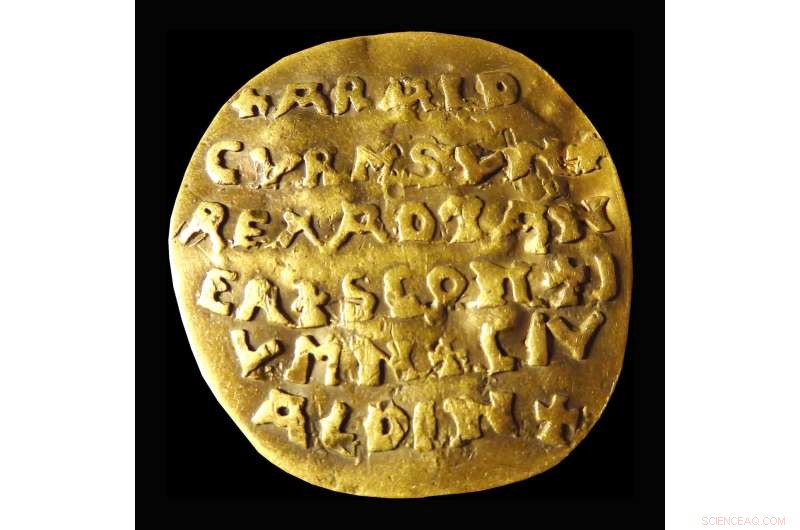
De 10e-eeuwse gouden Curmsun-schijf met de naam van de Deense koning Harald "Bluetooth" Gormsson (Curmsun in het Latijn) erop, afkomstig uit een graf in de rooms-katholieke kerk in Wiejkowo, Polen, gefotografeerd in Malmö, Zweden, in 2015. De Bluetooth draadloze verbindingstechnologie is vernoemd naar de koning. Meer dan 1000 jaar na zijn dood in wat nu Polen is, staat een Deense koning wiens bijnaam wereldwijd bekend is door de Bluetooth-technologie centraal in een archeologisch geschil. Krediet:Sven Rosborn via AP
Meer dan 1000 jaar na zijn dood in wat nu Polen is, staat een Europese koning wiens bijnaam voortleeft via draadloze technologie centraal in een archeologisch geschil.
Volgens kronieken uit de middeleeuwen kreeg koning Harald "Bluetooth" Gormsson van Denemarken zijn bijnaam dankzij een tand, waarschijnlijk dood, die er blauw uitzag. Een kroniek uit die tijd zegt ook dat de Vikingkoning aan het einde van de 10e eeuw werd begraven in Roskilde, in Denemarken.
Maar een Zweedse archeoloog en een Poolse onderzoeker beweerden onlangs in afzonderlijke publicaties dat ze zijn meest waarschijnlijke begraafplaats hebben gevonden in het dorp Wiejkowo, in een gebied in het noordwesten van Polen dat banden had met de Vikingen in de tijd van Harald.
Marek Kryda, auteur van het boek "Viking Poland", vertelde The Associated Press dat een "heidense heuvel", die hij beweert te hebben gevonden onder de 19e-eeuwse rooms-katholieke kerk van Wiejkowo, waarschijnlijk de overblijfselen van de koning bevat. Kryda zei dat geologische satellietbeelden beschikbaar op een portaal van de Poolse regering een ronde vorm lieten zien die eruitzag als een Viking-grafheuvel.
Maar de Zweedse archeoloog Sven Rosborn zegt dat Kryda ongelijk heeft omdat Harald, die zich van het heidendom tot het christendom bekeerde en kerken in het gebied stichtte, ergens op het kerkhof een passend graf moet hebben gekregen. Wiejkowo's Kerk van de Onbevlekte Ontvangenis van de Heilige Maagd Maria staat bovenop een kleine ronde heuvel.
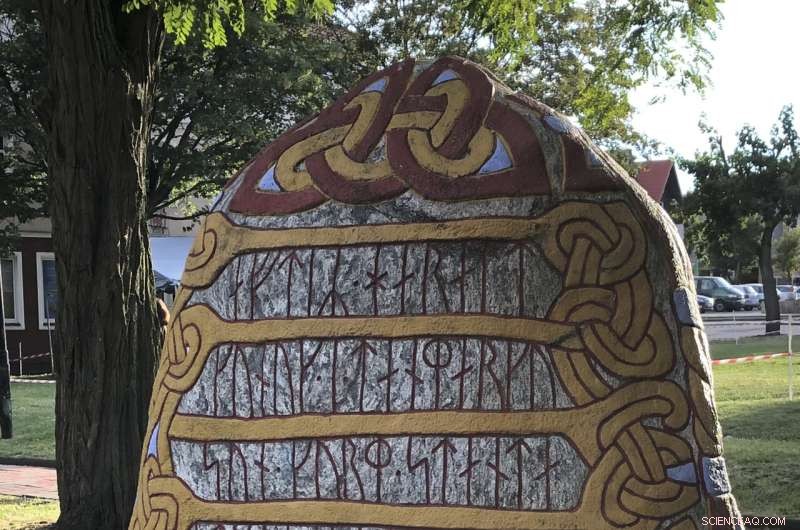
Een zicht op een steen uit 2014 met runeninscriptie ter nagedachtenis aan de Deense 10e-eeuwse koning Harald "Bluetooth" Gormsson, in Wolin, Polen, zaterdag 30 juli 2022. Meer dan 1000 jaar na zijn dood in wat nu Polen is, staat een Deense koning wiens bijnaam wereldwijd bekend is door de Bluetooth-technologie centraal in een archeologisch geschil. Een Poolse onderzoeker en een Zweedse archeoloog beweren dat ze de vermoedelijke begraafplaats voor koning Harald Bluetooth Gormsson hebben gevonden in een klein dorpje in het noordwesten van Polen, een gebied dat ooit banden had met de Vikingen. Krediet:AP-foto Monika Scislowska
Historici van het Deense Nationale Museum in Kopenhagen zeggen dat ze bekend zijn met de "suggestie" dat Wiejkowo de begraafplaats van Harald is.
Rosborn heeft zijn onderzoek gedetailleerd beschreven in het boek "The Viking King's Golden Treasure" uit 2021 en Kryda betwistte enkele van de bevindingen van de Zweed in zijn eigen boek dat dit jaar werd gepubliceerd.
Harald, who died in 985, probably in Jomsborg—which is believed to be the Polish town of Wolin now—was one of the last Viking kings to rule over what is now Denmark, northern Germany, and parts of Sweden and Norway. He spread Christianity in his kingdom.
Swedish telecommunications company Ericsson named its Bluetooth wireless link technology after the king, reflecting how he united much of Scandinavia during his lifetime. The logo for the technology is designed from the Scandinavian runic letters for the king's initials, HB.
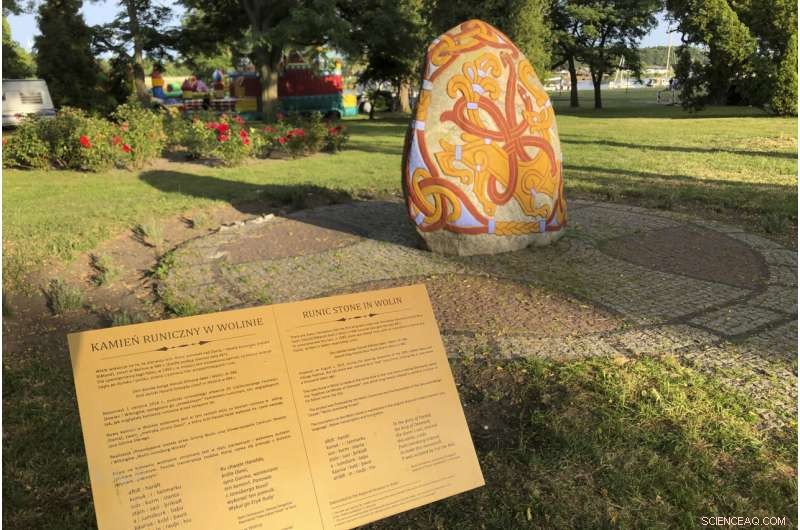
A view of a 2014 stone with runic inscription in memory of Danish 10th century King Harald “Bluetooth” Gormsson, in Wolin, Poland, Saturday, July 30,2022. More than 1,000 years after his death in what is now Poland, a Danish king whose nickname is known to the world through the Bluetooth technology is at the center of an archeological dispute. A Polish researcher and a Swedish archeologist claim that they have pinpointed the probable burial site for King Harald Bluetooth Gormsson in a small village in northwestern Poland, an area that once had ties with the Vikings. Credit:AP Photo Monika Scislowska
Rosborn, the former director of Sweden's Malmo City Museum, was spurred on his quest in 2014 when an 11-year-old girl sought his opinion about a small, soiled coin-like object with old-looking text that had been in her family's possession for decades.
Experts have determined that the cast gold disk that sparked Maja Sielski's curiosity dated from the 10th century. The Latin inscription on what is now known as the "Curmsun disk" says:"Harald Gormsson (Curmsun in Latin) king of Danes, Scania, Jomsborg, town Aldinburg."
Sielski's family, who moved to Sweden from Poland in 1986, said the disk came from a trove found in 1841 in a tomb underneath the Wiejkowo church, which replaced a medieval chapel.
The Sielski family came into the possession of the disk, along with the Wiejkowo parish archives that contained medieval parchment chronicles in Latin, in 1945 as the former German area was becoming part of Poland as a result of World War II.
-

The Roman Catholic church where it is believed that Danish King Harald Gormsson was buried, in Wiejkowo, Poland, Saturday, July 30, 2022. More than 1,000 years after his death in what is now Poland, a Danish king whose nickname is known to the world through the Bluetooth technology is at the center of an archeological dispute. A Polish researcher and a Swedish archeologist claim that they have pinpointed the probable burial site for King Harald Bluetooth Gormsson in a small village in northwestern Poland, an area that once had ties with the Vikings. Credit:AP Photo Monika Scislowska
-
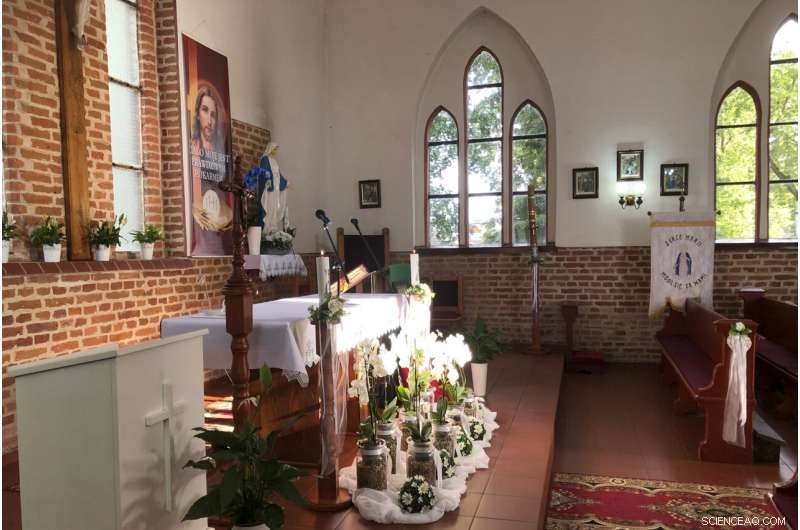
A view inside the Roman Catholic church where it is believed that Danish King Harald Gormsson was buried, in Wiejkowo, Poland, Saturday, July 30, 2022. More than 1,000 years after his death in what is now Poland, a Danish king whose nickname is known to the world through the Bluetooth technology is at the center of an archeological dispute. A Polish researcher and a Swedish archeologist claim that they have pinpointed the probable burial site for King Harald Bluetooth Gormsson in a small village in northwestern Poland, an area that once had ties with the Vikings. Credit:AP Photo Monika Scislowska
-
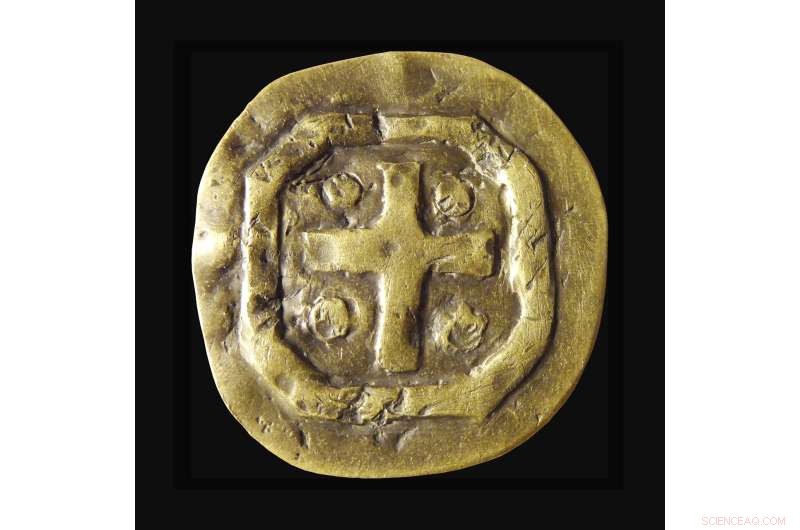
The 10th century golden Curmsun disc with the name of Danish King Harald “Bluetooth“ Gormsson (Curmsun in Latin) on it, coming from a tomb at the Roman Catholic church in Wiejkowo, Poland, photographed in Malmo, Sweden, in 2015. The Bluetooth wireless link technology is named after the king. More than 1,000 years after his death in what is now Poland, a Danish king whose nickname is known to the world through the Bluetooth technology is at the center of an archeological dispute. Credit:Sven Rosborn via AP
A family member who knew Latin understood the value of the chronicles—which dated as far back as the 10th century—and translated some of them into Polish. They mention Harald, another fact linking the Wiejkowo church to him.
The nearby Baltic Sea island and town of Wolin cultivates the region's Viking history:it has a runic stone in honor of Harald Bluetooth and holds annual festivals of Slavs and Vikings.
Kryda says the Curmsun disk is "phenomenal" with its meaningful inscription and insists that it would be worth it to examine Wiejkowo as Harald's burial place, but there are no current plans for any excavations. + Verder verkennen
Archaeologists find silver treasure on German Baltic island
© 2022 The Associated Press. Alle rechten voorbehouden. Dit materiaal mag niet worden gepubliceerd, uitgezonden, herschreven of opnieuw verspreid zonder toestemming.
 Menselijke cellen nemen minder eiwitten op uit plantaardig vlees dan uit kip
Menselijke cellen nemen minder eiwitten op uit plantaardig vlees dan uit kip Metalen gebruiken als brandstof
Metalen gebruiken als brandstof Nieuwe deuren openen:eerste synthetisch mechanisch gevoelig kaliumkanaal
Nieuwe deuren openen:eerste synthetisch mechanisch gevoelig kaliumkanaal Doorbraak in industrieel CO2-gebruik
Doorbraak in industrieel CO2-gebruik Algoritme leidt tot een dramatische verbetering van methoden voor het ontdekken van geneesmiddelen
Algoritme leidt tot een dramatische verbetering van methoden voor het ontdekken van geneesmiddelen
 Hoe het beheer van stikstofmeststoffen de bodemconcentratie en oppervlakteflux beïnvloedt
Hoe het beheer van stikstofmeststoffen de bodemconcentratie en oppervlakteflux beïnvloedt Meer dan alleen kooldioxide:het is tijd om kortstondige klimaatveroorzakende verontreinigende stoffen aan te pakken
Meer dan alleen kooldioxide:het is tijd om kortstondige klimaatveroorzakende verontreinigende stoffen aan te pakken Ideeën voor schoolprojecten op insecten
Ideeën voor schoolprojecten op insecten Wat is de functie van eierstokken van bloemen?
Wat is de functie van eierstokken van bloemen?  Type gesteente onder bossen heeft grote invloed op de groei van bomen, soort, koolstofopslag
Type gesteente onder bossen heeft grote invloed op de groei van bomen, soort, koolstofopslag
Hoofdlijnen
- Voedingsproduct op basis van schimmels dat smaakt en verscheurt als vlees
- Hoe stuifmeel werkt
- Hoe je je handen kunt wassen om sperma te doden
- Een celmodel maken Styrofoam Ball
- Wanneer is lachen een medisch symptoom?
- Wormsoorten verloren 7, 000 genen na evolutie om zichzelf te bevruchten
- 10 manieren om jezelf gelukkig te maken
- Stamboom van Homo Sapiens blijft evolueren
- Zou het hebben van een eigen kloon hetzelfde zijn als het hebben van een identieke tweeling?
- De plaag van seksueel geweld in West-Afrika, onthuld

- Pogingen om vloeken te verbieden zijn tijdverspilling:overal waar taal is, mensen vloeken

- Studie identificeert psychologie van aantrekking tot religieuze goden en superhelden

- Wat is een rekenkundige reeks?

- Het gebruik van de voedselbank steeg tijdens de pandemie – maar ze kunnen zelden alle hulp bieden die mensen nodig hebben

 Bezorgdheid over klimaatverandering niet beïnvloed door pandemie, studie toont
Bezorgdheid over klimaatverandering niet beïnvloed door pandemie, studie toont Er leven al miljoenen jaren minuscule loopvogels in de wetlands van Nieuw-Zeeland
Er leven al miljoenen jaren minuscule loopvogels in de wetlands van Nieuw-Zeeland NASA's eerste vrouwelijke kandidaat-astronaut, Jerry Cobb, overlijdt
NASA's eerste vrouwelijke kandidaat-astronaut, Jerry Cobb, overlijdt Waarom sluiten jongeren zich aan bij bendes? Leden leggen uit hoe aantrekkelijk het is om risico's te nemen
Waarom sluiten jongeren zich aan bij bendes? Leden leggen uit hoe aantrekkelijk het is om risico's te nemen De Saguaro Cactus is een iconisch symbool van het Amerikaanse zuidwesten
De Saguaro Cactus is een iconisch symbool van het Amerikaanse zuidwesten  De voordelen en nadelen van biomassa Energy
De voordelen en nadelen van biomassa Energy Bezorgd dat je op Facebook zit? Enkele opties uitgelegd
Bezorgd dat je op Facebook zit? Enkele opties uitgelegd Kooldioxide omzetten in waardevolle producten
Kooldioxide omzetten in waardevolle producten
- Elektronica
- Biologie
- Zonsverduistering
- Wiskunde
- French | Italian | Spanish | Portuguese | Swedish | German | Dutch | Danish | Norway |

-
Wetenschap © https://nl.scienceaq.com

